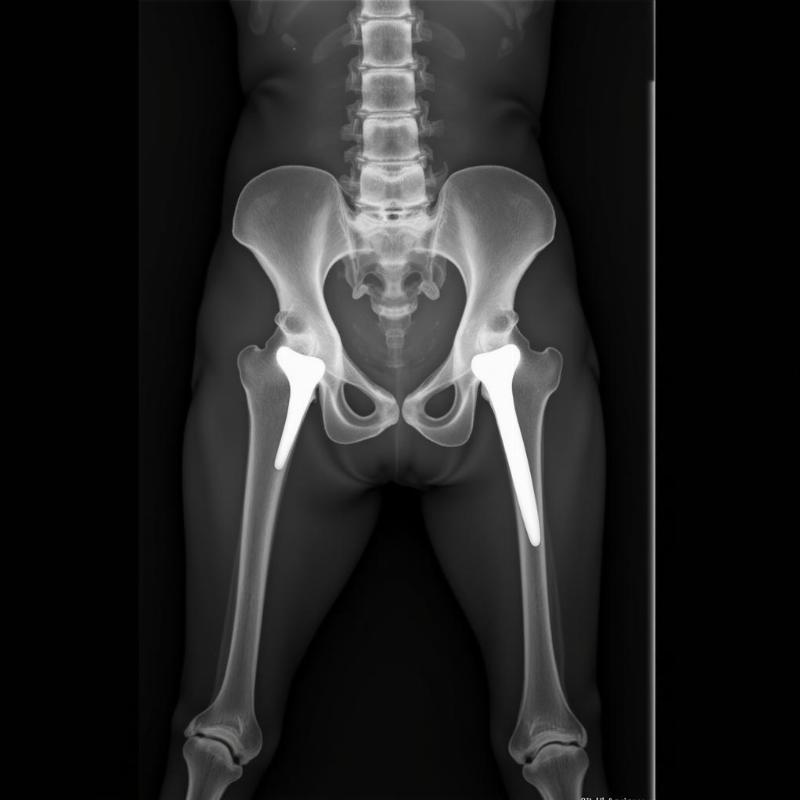Hip dysplasia is a common and painful condition affecting dogs, particularly larger breeds. Understanding how x-rays are used to diagnose and monitor this debilitating disease is crucial for responsible pet owners. X-rays of dogs with hip dysplasia provide a critical visual representation of the joint, allowing veterinarians to assess the severity and make informed treatment decisions. This article will delve into the specifics of canine hip dysplasia x-rays, explaining what they reveal and why they’re essential.
Understanding Hip Dysplasia in Dogs
Hip dysplasia in dogs occurs when the hip joint doesn’t develop correctly. This leads to looseness, instability, and eventual deterioration of the joint. The ball and socket don’t fit snugly, causing friction and pain. Over time, this can lead to arthritis and significantly reduce a dog’s mobility and quality of life. Recognizing the signs of hip dysplasia, such as difficulty rising, lameness, and a reluctance to exercise, is crucial for early intervention. dogs front legs giving out
What Do X Rays of Dogs with Hip Dysplasia Show?
X-rays provide a clear picture of the bones and joints, allowing veterinarians to see the extent of the damage caused by hip dysplasia. They reveal the degree of joint laxity, the presence of osteoarthritis, and any other abnormalities. Specific features that veterinarians look for in x-rays of dogs with hip dysplasia include:
- Joint Laxity: This is the looseness of the joint, indicating how well the ball fits into the socket.
- Osteoarthritis: X-rays can show bone spurs, joint space narrowing, and other signs of arthritis.
- Subluxation or Dislocation: The femoral head (ball) can be partially or completely out of the acetabulum (socket).
The Importance of Early Diagnosis through X-Rays
Early diagnosis of hip dysplasia is essential for effective management. While physical exams can suggest hip dysplasia, x-rays provide definitive confirmation and allow veterinarians to stage the severity of the condition. This information is crucial for developing a tailored treatment plan. senior dogs back legs giving out
 Dog x-ray of hip dysplasia showing arthritis
Dog x-ray of hip dysplasia showing arthritis
Different X-Ray Techniques for Diagnosing Hip Dysplasia
Several x-ray techniques can be used to diagnose hip dysplasia. The standard view is the ventrodorsal projection, which is taken with the dog lying on its back. Other views, such as the PennHIP method, can provide more detailed information about joint laxity. Your veterinarian will determine the best approach based on your dog’s age, breed, and symptoms. dogs hips clicking when walking
Treating Hip Dysplasia: What to Expect After the X-Ray
Treatment options vary depending on the severity of the dysplasia and the dog’s age and overall health. Options range from conservative management with medication and weight control to surgical interventions.
- Conservative Management: This may include pain relievers, anti-inflammatory drugs, joint supplements, and physical therapy.
- Surgical Options: Several surgical procedures, such as total hip replacement or femoral head ostectomy, may be recommended in more severe cases.
Conclusion
X-rays of dogs with hip dysplasia are a vital diagnostic tool. They provide crucial information about the severity of the condition, guiding treatment decisions and ultimately helping improve the dog’s quality of life. Early diagnosis through x-rays is key to effective management and can help prevent long-term complications. dog hip dysplasia x ray vs normal
FAQ
- When should I have my dog’s hips x-rayed? Your veterinarian may recommend x-rays as early as two years of age, especially for large breeds prone to hip dysplasia.
- Is the x-ray procedure painful for dogs? No, the procedure itself is not painful. However, sedation may be required for proper positioning.
- How much do hip x-rays for dogs cost? The cost varies depending on your location and the veterinary clinic.
- Are there any alternatives to x-rays for diagnosing hip dysplasia? While physical exams can suggest dysplasia, x-rays are the gold standard for definitive diagnosis.
- Can hip dysplasia be cured? While there’s no cure, various treatments can manage the condition and improve a dog’s comfort and mobility.
- What breeds are most prone to hip dysplasia? Large and giant breeds, such as German Shepherds, Golden Retrievers, and Labrador Retrievers, are at higher risk.
- Is hip dysplasia hereditary? Yes, genetics play a significant role in the development of hip dysplasia.
Beautdogs.us is your premier source for expert advice on dog care, breed information, and product reviews. Whether you’re a seasoned dog owner or just starting out, Beautdogs.us offers comprehensive and engaging content to help you provide the best possible care for your canine companion. We are dedicated to empowering dog owners with reliable information and resources. For more information and personalized advice, contact us at [email protected] or call us at +1 501-555-7529. Visit Beautdogs.us for all your dog-related needs!